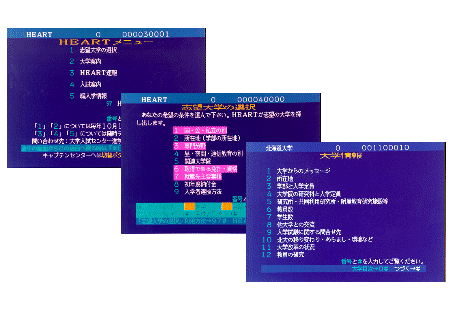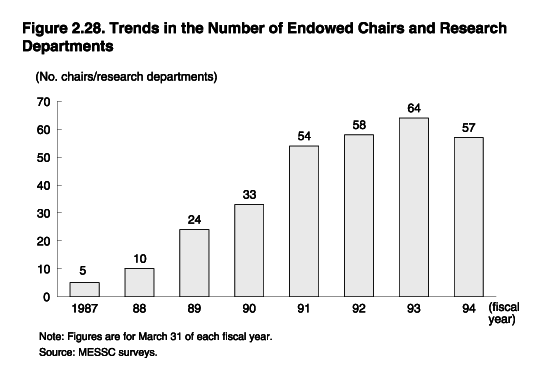| Home > Policy > White Paper, Notice, Announcement > White Paper > JAPANESE GOVERMENT POLICIES IN EDUCATION, SCIENCE, SPORTS AND CULTURE 1995 > Remaking Universities Chapter 2 Section 3 3 | ||
As members of society, universities are expected to participate actively in and contribute to community life through close communication with their local communities. This demand is reflected in the efforts of individual universities to make themselves more open to their communities and to inform the community about their educational philosophies and activities. In addition to the publication of university pamphlets and articles in magazines and other media, this is being achieved through the publication of syllabuses and self-monitoring and self-evaluation reports. Many universities distribute reports and other information to upper secondary schools, public libraries, boards of education, and other organizations in the prefectures in which they are located. In this way they are able to disseminate university information throughout the community while fostering public understanding of universities.
Since the autumn of 1993 it has been possible to access information about universities, including not only details of entrance examinations but also information about university characteristics and such areas as educational content and progress toward university reform, through computer terminals in upper secondary schools, libraries, and other facilities. This information, which is supplied by universities, is made available through the HEART System established by the NCUEE.

In addition to self-monitoring and self-evaluation, some universities commission evaluations by outside experts in order to gain greater objectivity. Sometimes the findings of these evaluations are published. As of October 1994, nine faculties and research institutes in five universities had commissioned and published evaluations by outside experts.
A growing number of universities are examining the issues that confront them and their concepts for the future from a broader perspective by establishing discussion groups that include outside experts. In addition, some universities use questionnaire surveys to seek the views and assessments of companies that employ large numbers of their graduates each year. Their purpose is to obtain information for use in future reform efforts by ascertaining their image from the business viewpoint.
The Japanese University Accreditation Association has worked for many years to improve the quality of Japanese universities by conducting assessments to determine whether individual universities qualify for full membership in the association. The association plans to begin implementing regular reciprocal evaluations of full-member universities in fiscal 1996.
By seeking outside evaluations, universities can gain concrete information about the role that the community wants them to play and can identify more clearly the areas in which improvements are needed. They can also revitalize their organizations by applying feedback from outside evaluations to the university reform process. For people not directly involved with universities, these evaluations provide a way of gaining a better understanding of universities and can lead to closer coordination and cooperation with them.
The development of new fields of activity through constant technological innovation is vital to Japan's continued economic vitality. Cooperation between universities and industry plays an extremely important role in the development of innovative technology. For universities, close interaction with industry is a valuable means of improving the educational and research environment and revitalizing university activities. In recent years universities and industry have been working together more closely through various means, including the activities of linked graduate schools and the provision of refresher education for workers.
Especially significant is the growing trend toward the acceptance of endowments from corporations and other private-sector sources. An increasing number of universities are establishing endowed chairs and research departments and using such endowments to pay the salaries of faculty members or cover the research expenses of faculty and students. As of fiscal 1994 a total of 57 endowed chairs and research departments had been established in 23 national universities and in 1 interuniversity research institute ( Figure 2.28 ).
To develop into distinctive educational institutions, universities need to play a central role in educational and research activities in their regions. They also need to make an active contribution in response to regional needs, making full use of their human and material resources.In recent years more and more universities have been helping to meet the needs of their regions and local communities by providing access to university facilities, by establishing extension courses as part of lifelong learning activities, and by cooperating in lifelong learning programs established by boards of education and other organizations. In fiscal 1993 a total of 544,101 people participated in 4,590 extension courses at 452 universities, or over 80% of all universities. Course content is extremely varied. Some courses are designed to raise the level of general education, while others are vocational. There are also courses that reflect unique characteristics of individual universities or regions, such as "children "s adventure school," "the impact of the Huis ten Bosch Theme Park on Sasebo," and "transportation problems in Kyoto City."

| Back to Top | MEXT HOME |